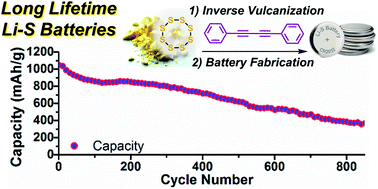Inverse vulcanization of elemental sulfur with 1,4-diphenylbutadiyne for cathode materials in Li–S batteries†
Abstract
High sulfur content copolymers were prepared via inverse vulcanization of sulfur with 1,4-diphenylbutadiyne (DiPhDY) for use as the active cathode material in lithium–sulfur batteries. These sulfur-rich polymers exhibited excellent capacity retention (800 mA h g−1 at 300 cycles) and extended battery lifetimes of over 850 cycles at C/5 rate.

- This article is part of the themed collection: Polymers for Electrochemical Energy Storage

 Please wait while we load your content...
Please wait while we load your content...